📞+86 153 7530 2641 📧 hongjing.Wang@feichuncables.com
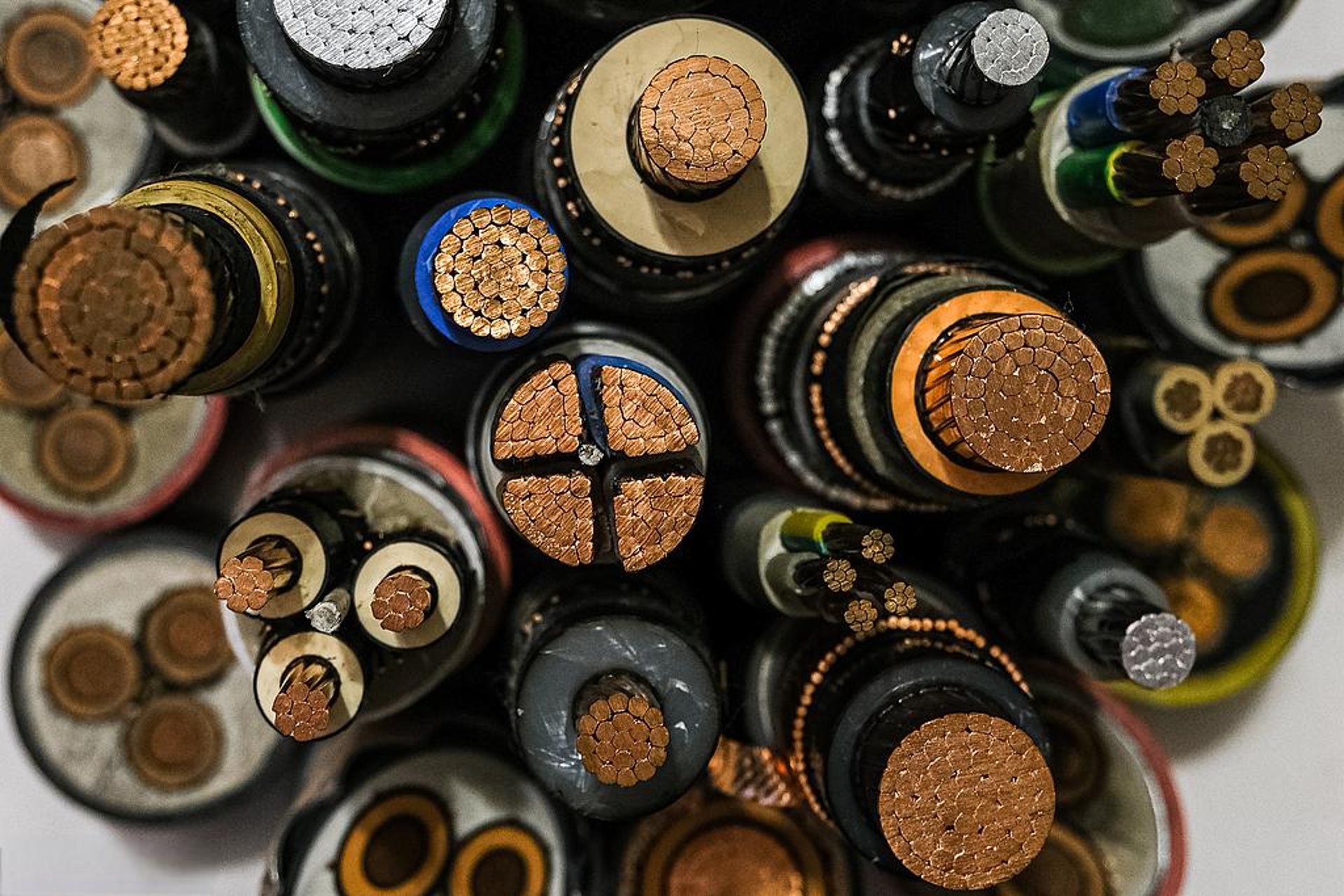
What are the best polymeric materials for cable insulation and sheathing applications?
Discover the best polymeric materials for cable insulation and sheathing. Learn how thermoplastic and thermosetting compounds impact cable performance.
hongjing.Wang@Feichun
8/7/202511 min read
Introduction
The modern electrical infrastructure relies heavily on the sophisticated engineering of cable systems, where polymeric materials serve as the backbone for both cable insulation and cable sheathing applications. These specialized compounds have revolutionized the cable industry by providing superior electrical, mechanical, and environmental protection compared to traditional materials. The selection of appropriate polymeric materials directly impacts cable performance, safety, and longevity across diverse applications ranging from residential wiring to high-voltage transmission systems.
Understanding the intricacies of different polymer compounds is crucial for engineers, procurement specialists, and industry professionals who must navigate the complex landscape of cable specifications. Each polymeric material offers unique characteristics that make it suitable for specific environmental conditions and operational requirements. The distinction between thermoplastic and thermosetting materials, along with their respective additives and formulations, determines the ultimate performance capabilities of the finished cable product.
1. Why are polymeric materials essential in cable design?
Polymeric materials have become indispensable in modern cable design due to their exceptional versatility and performance characteristics. These materials provide critical electrical, mechanical, and environmental protection that ensures safe and reliable power transmission across various applications. The importance of polymeric materials in cables extends beyond basic functionality to encompass safety, durability, and operational efficiency.
The function of cable insulation and sheath serves distinct but complementary purposes within the cable assembly. Cable insulation materials are specifically engineered to separate conductors from each other and from ground potential, preventing short circuits and electrical failures. This insulating barrier must maintain its dielectric properties across varying voltage levels, temperatures, and environmental conditions. The insulation must be completely effective in withstanding voltage stress while maintaining structural integrity throughout the cable's operational lifetime.
Cable sheathing serves as the protective outer layer that shields internal components from harmful external influences. These protective compounds guard against temperature extremes, moisture ingress, chemical exposure, mechanical damage, UV radiation, and biological threats such as rodents or mold. The sheath essentially acts as the first line of defense, ensuring that the critical insulation and conductor elements remain protected from environmental degradation.
The synergistic relationship between insulation and sheathing materials creates a comprehensive protection system that enables cables to operate reliably in challenging environments. Modern polymeric materials offer superior performance compared to traditional materials like rubber or paper, providing enhanced electrical properties, improved mechanical strength, and extended service life.
2. Thermoplastic vs Thermosetting: What's the Difference?
Understanding the fundamental differences between thermoplastic cable compounds and thermosetting cable insulation is crucial for proper material selection. These two categories represent distinct approaches to polymer chemistry, each offering specific advantages for different cable applications.
Thermoplastic materials become pliable and moldable when heated to elevated temperatures, typically between 110°C to 180°C, and solidify upon cooling. This reversible process allows thermoplastics to be reprocessed and recycled, making them environmentally advantageous. The polymer chains in thermoplastics are held together by intermolecular forces that weaken with increased temperature, creating a viscous liquid state suitable for extrusion and molding processes.
Common thermoplastic materials used in cable applications include Polyvinyl Chloride (PVC), Polyethylene (PE), Nylon, and Low Smoke Zero Halogen (LSZH) compounds. These materials offer excellent processability, consistent quality, and cost-effectiveness for many standard applications. PVC remains particularly popular due to its balanced properties, flame resistance, and economic advantages.
Thermosetting materials, conversely, undergo irreversible chemical changes during the curing process, forming permanent cross-links between polymer chains. This cross-linking process, also known as vulcanization or curing, creates a three-dimensional network structure that provides superior mechanical properties and temperature resistance. Once cured, thermosetting materials cannot be remelted or reformed, which limits recyclability but enhances performance characteristics.
Key thermosetting materials include Ethylene Propylene Rubber (EPR), Cross-linked Polyethylene (XLPE), Silicone Rubber, and Chlorosulfonated Polyethylene (CSP). These elastomeric compounds exhibit excellent flexibility, temperature resistance, and long-term stability. The cross-linking process allows thermosetting materials to maintain their properties across wider temperature ranges and provides superior resistance to deformation under mechanical stress.
3. Common Polymeric Materials Used in Cable Insulation
XLPE (Cross-linked Polyethylene)
XLPE insulation cables represent one of the most significant advances in power cable technology. Cross-linked polyethylene combines the excellent electrical properties of polyethylene with enhanced thermal and mechanical characteristics achieved through the cross-linking process. XLPE demonstrates superior dielectric strength, low dielectric constant, and excellent resistance to electrical treeing, making it ideal for medium and high-voltage applications.
The cross-linking process transforms the thermoplastic polyethylene into a thermosetting material that maintains structural integrity at elevated temperatures up to 90°C continuously and 250°C for short-circuit conditions. This temperature capability represents a significant improvement over traditional PVC insulation, enabling higher current carrying capacity and improved cable ratings.
PVC (Polyvinyl Chloride)
PVC remains a cornerstone material in cable insulation due to its balanced combination of electrical properties, flame resistance, and economic advantages. PVC insulation provides reliable performance across a wide range of applications, from residential wiring to industrial installations. The material demonstrates good dielectric strength and inherent flame retardancy due to its chlorine content.
Modern PVC compounds incorporate various additives to enhance specific properties such as flexibility at low temperatures, UV resistance, and thermal stability. The versatility of PVC formulations allows manufacturers to tailor the material characteristics to meet specific application requirements.
EPR vs XLPE insulation
EPR (Ethylene Propylene Rubber) and EPDM (Ethylene Propylene Diene Monomer) represent advanced elastomeric insulation materials that offer superior flexibility and temperature resistance. These materials excel in applications requiring excellent low-temperature performance and mechanical flexibility. EPR insulation maintains its properties across temperature ranges from -40°C to 90°C, making it suitable for outdoor and underground installations.
The comparison between EPR and XLPE reveals distinct advantages for each material. While XLPE offers superior electrical properties and higher temperature ratings, EPR provides better flexibility and tear resistance. The choice between these materials depends on specific application requirements and environmental conditions.
Silicone Rubber
Silicone rubber insulation represents the premium choice for extreme temperature applications and fire-resistant installations. This material maintains flexibility across temperature ranges from -60°C to 200°C while providing excellent electrical properties and outstanding fire performance. Silicone rubber continues to function even when exposed to flames, making it essential for fire survival cables and critical safety systems.
LSZH (Low Smoke Zero Halogen)
Best insulation materials for power cables in enclosed spaces increasingly include LSZH compounds that minimize toxic emissions during fire conditions. These materials provide essential safety benefits in tunnels, buildings, and transportation applications where smoke toxicity poses significant risks to human safety. LSZH insulation combines flame retardancy with reduced smoke generation and halogen-free formulations.
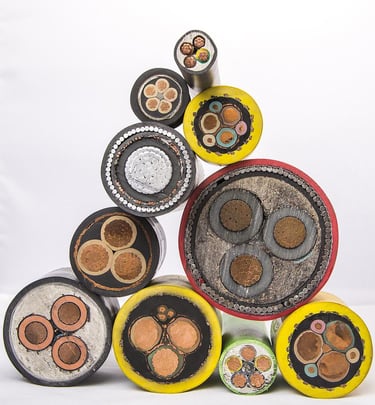

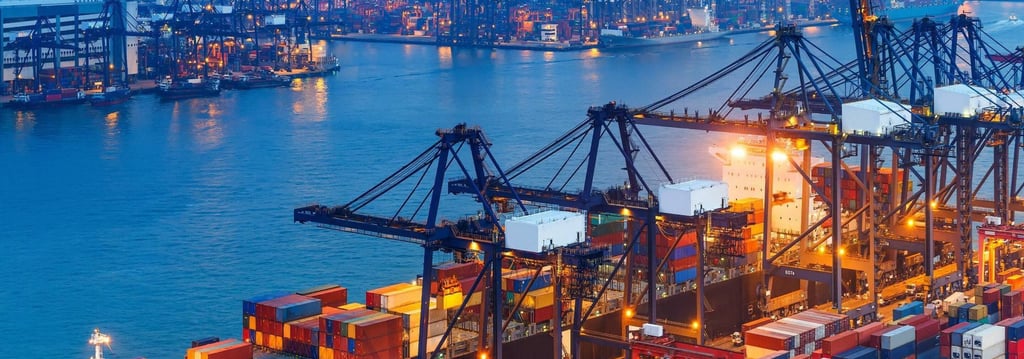

4. Polymeric Materials Used in Cable Sheathing
PVC Sheath
PVC sheathing materials provide robust mechanical protection and weather resistance for general-purpose cable applications. The inherent flame retardancy and chemical resistance of PVC make it suitable for both indoor and outdoor installations. Modern PVC sheath compounds incorporate UV stabilizers and plasticizers to enhance outdoor performance and maintain flexibility across temperature variations.
CPE (Chlorinated Polyethylene)
Cable sheath materials based on CPE offer enhanced oil and chemical resistance compared to standard PVC compounds. CPE provides excellent mechanical properties and maintains flexibility across wider temperature ranges, making it suitable for industrial environments with exposure to oils, chemicals, and extreme temperatures.
PUR (Polyurethane Rubber)
Outdoor cable sheathing materials increasingly utilize polyurethane rubber for applications requiring superior abrasion resistance and flexibility. PUR sheathing demonstrates exceptional tear strength and cut-through resistance, making it ideal for mobile equipment, robotics, and applications with repeated flexing requirements.
CSP (Chlorosulfonated Polyethylene)
Chemical-resistant cable jackets often employ CSP compounds that provide outstanding resistance to oils, chemicals, and weathering. CSP materials maintain their properties when exposed to UV radiation, ozone, and various industrial chemicals, making them suitable for harsh outdoor and industrial environments.
MDPE and HDPE
Medium-density polyethylene (MDPE) and high-density polyethylene (HDPE) serve as economical sheathing options for underground and direct burial applications. These materials offer excellent moisture resistance and chemical inertness while providing adequate mechanical protection for buried cables.
5. Additives in Cable Compound Formulations
Modern cable polymer additives play a crucial role in transforming basic polymers into high-performance compounds suitable for specific applications. Pure polymers rarely possess all the characteristics required for cable applications, necessitating the incorporation of various additives to optimize performance.
Polymer compound engineering involves the careful selection and proportioning of additives to achieve desired properties. Fillers are incorporated to improve electrical properties, enhance thermal conductivity, or modify mechanical characteristics. Common fillers include calcium carbonate, silica, and aluminum trihydrate, each providing specific property enhancements.
Plasticizers are essential for enhancing flexibility, particularly at low temperatures where polymer chains become rigid. These additives enable cables to maintain flexibility during installation and operation in cold environments. The selection and concentration of plasticizers directly impact the cable's low-temperature performance and handling characteristics.
Antioxidants prevent premature thermal aging by inhibiting oxidative degradation of the polymer chains. These additives are crucial for maintaining long-term performance, especially in elevated temperature applications. Complementary antiozonants protect against ozone attack, which can cause surface cracking and degradation in outdoor applications.
UV stabilizers are incorporated to prevent photodegradation from ultraviolet radiation exposure. These additives are particularly important for outdoor cable applications where sunlight exposure can cause color fading, surface chalking, and mechanical property degradation.
Curing agents and accelerators are essential components in thermosetting compounds, promoting the cross-linking reactions that create the three-dimensional network structure. The selection and concentration of these additives control the curing rate and final properties of the cross-linked material.
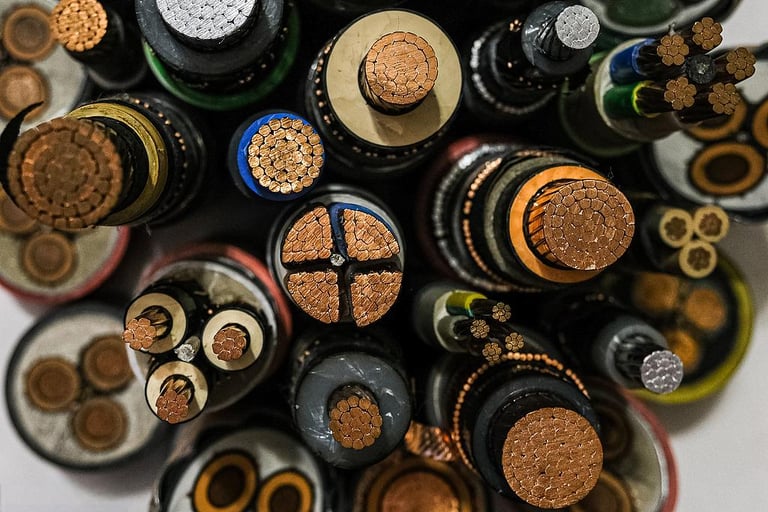

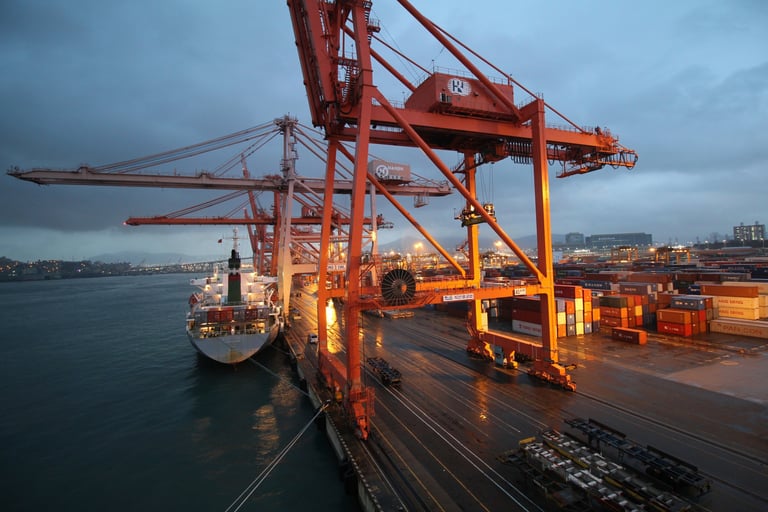

6. Selection Criteria: How to Choose the Right Polymeric Material?
Determining how to choose cable insulation material requires comprehensive analysis of environmental conditions, electrical requirements, and mechanical stresses. The selection process must consider multiple factors that impact cable performance throughout its operational lifetime.
Temperature range represents a primary consideration, as polymeric materials exhibit varying performance characteristics across different temperature extremes. Applications requiring operation in extreme cold necessitate materials that maintain flexibility and mechanical properties at low temperatures, such as EPR or specialized XLPE formulations. Conversely, high-temperature applications require materials with enhanced thermal stability and cross-linked structures.
Chemical exposure analysis is crucial for industrial and marine applications where cables encounter aggressive chemicals, oils, or corrosive substances. The best polymer for harsh environments often includes specialized compounds like CSP or PUR that provide superior chemical resistance while maintaining mechanical integrity.
Fire resistance requirements drive the selection of LSZH materials or inherently flame-retardant compounds like PVC. Critical safety applications, including tunnels, high-rise buildings, and transportation systems, mandate materials that minimize fire propagation and toxic emissions during fire conditions.
Mechanical stress considerations encompass installation forces, operational flexing, and environmental stresses such as wind loading or ground movement. Applications involving repeated flexing, such as robotics or mining equipment, require materials with superior tear resistance and fatigue life.
Case studies demonstrate material selection principles across diverse applications. Marine cables require compounds with excellent water resistance, UV stability, and salt spray resistance, typically utilizing XLPE insulation with specialized sheathing compounds. Mining cables demand superior abrasion resistance, flame retardancy, and mechanical strength, often employing EPR insulation with PUR or CSP sheathing. Industrial automation cables require flexibility, oil resistance, and electromagnetic compatibility, leading to specialized compound formulations.
7. Future Trends in Cable Polymers
The future of cable materials focuses on sustainability, enhanced performance, and specialized applications. Environmental consciousness drives development of recyclable and bio-based polymers that reduce environmental impact while maintaining performance characteristics. Sustainable cable insulation materials incorporate recycled content and bio-based feedstocks without compromising electrical or mechanical properties.
High-performance thermoplastic elastomers (TPEs) represent emerging materials that combine the processability of thermoplastics with the performance characteristics of thermosets. These materials offer potential advantages in recyclability and processing efficiency while providing enhanced performance characteristics.
Advanced fire-resistant formulations continue evolving to meet increasingly stringent safety requirements. New additives and polymer modifications enhance fire performance while minimizing environmental impact and maintaining electrical properties. UV-resistant innovations address the growing demand for outdoor cable applications in harsh environments.
Nanotechnology integration promises enhanced properties through incorporation of nanofillers and nanostructured additives. These advanced materials may provide improved thermal conductivity, mechanical strength, and barrier properties while maintaining processing characteristics.
Smart materials incorporating sensors or self-healing capabilities represent potential future developments that could revolutionize cable monitoring and maintenance. These advanced concepts may enable real-time condition monitoring and automatic repair of minor damage.
Application Scenarios
Polymeric materials for cable insulation and sheathing find extensive applications across diverse industries and environments:
Power Distribution Networks: XLPE insulated cables dominate medium and high-voltage applications due to their superior electrical properties and thermal performance. Underground distribution systems utilize XLPE insulation with PE sheathing for moisture resistance and longevity.
Industrial Automation: Manufacturing facilities require cables with oil-resistant sheaths, flexible insulation, and electromagnetic compatibility. EPR insulation with PUR sheathing provides the necessary performance characteristics for robotic applications and automated equipment.
Marine and Offshore: Harsh marine environments demand specialized compounds resistant to saltwater, UV exposure, and extreme temperatures. Silicone rubber insulation with CSP sheathing provides reliable performance in offshore drilling platforms and marine vessels.
Transportation Systems: Railway and automotive applications require flame-retardant, low-smoke materials that maintain performance during temperature cycling and vibration exposure. LSZH compounds ensure passenger safety while providing reliable electrical performance.
Renewable Energy: Solar installations and wind farms require UV-stable, weather-resistant cables capable of 25-30 year service life. Specialized XLPE formulations with enhanced UV resistance enable reliable renewable energy systems.
Data Centers: Critical power applications demand fire-resistant cables with minimal smoke generation. LSZH compounds provide essential safety benefits while maintaining electrical performance for uninterruptible power systems.
Conclusion
The selection of appropriate polymeric materials for cable insulation and cable sheathing represents a critical engineering decision that impacts safety, performance, and operational costs throughout the cable's service life. Understanding the fundamental differences between thermoplastic and thermosetting materials, along with their respective advantages and limitations, enables informed material selection for specific applications.
The comprehensive range of available polymeric materials, from traditional PVC to advanced XLPE and specialty compounds like silicone rubber, provides solutions for virtually any application requirement. The key lies in matching material characteristics to environmental conditions, electrical requirements, and mechanical stresses encountered in specific installations.
Modern cable polymer additives and compound formulations allow manufacturers to tailor material properties to meet increasingly demanding specifications. This customization capability ensures that cables can perform reliably in harsh environments while maintaining safety and efficiency standards.
Future developments in sustainable materials, enhanced performance compounds, and smart technologies promise continued evolution in cable polymer technology. These advances will enable new applications while addressing environmental concerns and enhanced safety requirements.
The success of any cable installation ultimately depends on the careful selection and application of appropriate polymeric materials that provide the necessary protection, performance, and longevity for the intended application. Understanding these materials and their characteristics empowers engineers and specifiers to make informed decisions that ensure optimal cable performance throughout the system's operational lifetime.
Frequently Asked Questions (FAQs)
Q1: What is the difference between cable insulation and cable sheathing? A: Cable insulation provides electrical separation between conductors and prevents short circuits, while cable sheathing protects the entire cable assembly from external environmental influences such as moisture, chemicals, and mechanical damage.
Q2: Which is better for high-voltage applications: XLPE or EPR insulation? A: XLPE is generally preferred for high-voltage applications due to its superior dielectric properties, higher temperature rating (90°C vs 85°C for EPR), and better electrical aging characteristics. However, EPR offers better flexibility and is preferred for applications requiring frequent movement.
Q3: What are the best polymeric materials for cable insulation in fire-critical applications? A: LSZH (Low Smoke Zero Halogen) compounds and silicone rubber are the best choices for fire-critical applications. Silicone rubber maintains functionality even when exposed to flames, while LSZH materials minimize toxic smoke generation during fire conditions.
Q4: How do thermoplastic and thermosetting cable materials differ in terms of recyclability? A: Thermoplastic materials can be remelted and recycled multiple times, making them more environmentally friendly. Thermosetting materials undergo irreversible chemical changes and cannot be remelted, limiting their recyclability but providing superior performance characteristics.
Q5: What additives are essential in cable polymer compounds? A: Essential additives include antioxidants (prevent thermal aging), UV stabilizers (protect against sunlight), plasticizers (enhance flexibility), fillers (improve properties), and for thermosetting compounds, curing agents and accelerators to promote cross-linking.
Q6: Which sheathing materials offer the best chemical resistance? A: CSP (Chlorosulfonated Polyethylene) and PUR (Polyurethane Rubber) provide excellent chemical resistance. CSP offers outstanding resistance to oils and industrial chemicals, while PUR provides superior abrasion resistance and flexibility in chemical environments.
Q7: How do I choose the right polymeric material for outdoor cable installations? A: Consider UV resistance, temperature range, moisture resistance, and mechanical protection requirements. XLPE with HDPE sheathing works well for buried applications, while UV-stabilized compounds with enhanced weather resistance are necessary for aerial installations.
Q8: What are the advantages of compound formulations over pure polymers? A: Compound formulations allow customization of properties through additives, providing enhanced performance characteristics such as improved flexibility, flame resistance, UV protection, and chemical resistance that pure polymers cannot achieve alone.
How to Reach Us
Get in Touch
SiteMap
Product Catalogue
Reeling Cable
Festoon Cable
Shore Power Cable




Scan to add us on WeChat
